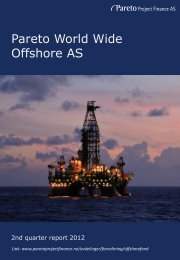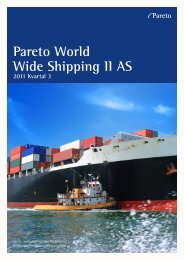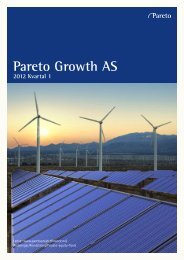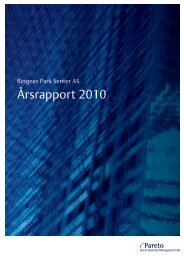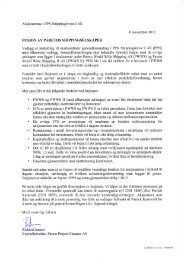Pareto World Wide Offshore AS - Pareto Project Finance
Pareto World Wide Offshore AS - Pareto Project Finance
Pareto World Wide Offshore AS - Pareto Project Finance
You also want an ePaper? Increase the reach of your titles
YUMPU automatically turns print PDFs into web optimized ePapers that Google loves.
The offshore oil services marketThe production challengeEven if discoveries are made, it appears that the mainchallenge is transferring the reserves into newproduction, while maintain output from existingreserves. The graph to the left exemplifies thischallenge through looking at what the 10 largest oilmajors have managed. Since 2007, these oilcompanies have guided an annual average productiongrowth of roughly 3%. The outcome, however, hasbeen an annual production decline of 0.5%. This isowed both to declining production from existing fields,plus the difficulties of getting new reserves to yieldaccording to expectations.During the past decade, the oil industry’s upstreaminvestments were more than twice as high as in theprevious decade, but there was no increase in the levelof new discoveries. Interestingly, reserves discoveredsince 2000 contribute with less than 5% of global oilproduction, illustrating the challenge of putting newreserves into production.Petrobras provides another striking example. During2006-10, Brazil accounted for 40% of global oildiscoveries. As a result, Petrobras launched ambitiousgrowth plans and targeted annual production from itsBrazilian reserves of 2.8-3.0mbd by 2014 and 3.4mbdin 2016. The outcome has been very disappointing, asproduction has stayed at around 2mbd. The mostrecent revision to its long term plan has revisedexpected production down to 2.5mbd by 2016. This isa downward adjustment of 26%.Why is this so? The new reserves generally lie in morecomplex reservoirs, in more remote locations, indeeper waters and so on. They require moreequipment and services to be extracted, which in turnputs pressure on the oil services industry to addresources. Lack of skilled labour, as well as longconstruction periods for complex assets like drillingrigs, production platforms, subsea vessels and generalinfrastructure, means that delays are the order of theday. Political hurdles add to this, particularly in WestAfrica. We regularly see that the time from discoveryto first oil for large, deepwater fields is about 10 years.As shown in the graph to the left, the size andcomplexity of typical deepwater field developments israpidly increasing (here the example is West Africa).





